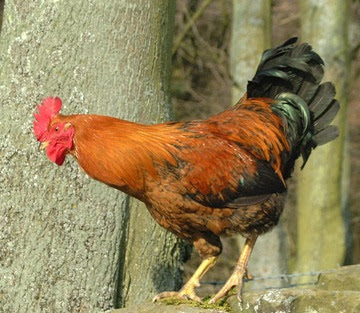photo from FreeFoto.com

The traditional - but unofficial - emblem of the French nation is the cockerel. In Latin, gallus means both 'cockerel' and 'Gaul' and symbolizes the fighting spirit of the nation (and is nothing to do with being chicken, whatever people say). It is also reminiscent of some of the more macho Gallic individuals who strut and flirt indiscriminately whenever a member of the female sex swans into view. The French phrase for this is faire le coq which means 'to act like a cockerel'.
The French are very fond of animals. They keep them as pets, they put them in zoos, they wear them as coats and, of course, they eat them. Well, we eat them too, don't we? Yet somehow, while many of us will quite happily chomp our way through pigs, cows and little bunny rabbits, we balk at the thought of roast horse with our Yorkshire pudding or donkey sausages on sticks. As for snails, these - along with frogs' legs - have come to represent typical French cuisine. While people generally only eat them on special occasions or in restaurants catering for foreign tourists, they still manage to chew through 45,000 tons of the beasts every year. Many of these are bred by héliciculteurs on snail farms and, if your idea of a fun afternoon is watching snails breed, you can book a guided tour. Some farms even offer picnic facilities - presumably on a pick-your-own basis. This isn't as far-fetched as it sounds. I remember seeing an elderly couple early one morning scurrying about in the rain picking things off the pavement. I thought perhaps one of them had dropped their pills or their pension but on closer inspection, I realised they were picking up huge, slimy snails…for lunch. Fast food, if you like, in an oxymoron kind of way…
Frogs' legs are one of the specialities of the Rhône Alpes, as frogs are to be found in abundance in the nearby swamps of La Dombes where, paradoxically, they are allowed to hop to their heart's content because they are now a protected species and it is against the law to catch them. Indonesian frogs, on the other hand, have no such luck. To read about how they are caught and slaughtered for export would put you off ever nibbling on a batrachian's thighbone again - if indeed you were at all tempted in the first place. France imports thousands of tons of frogs' legs from Indonesia every year and they still call it a national dish.
Donkey saucisson is another speciality of this region and horsemeat can be found in most supermarkets - an idea which can be hard to swallow for those who consider these animals as pets, not main courses. It's like eating kitten casserole or puppy stew, for goodness sake. And foie gras is a bit more than a tasty meat spread - it is the fattened liver of some poor goose which has been force-fed by means of a funnel rammed down its neck. Phew. I'm so glad I'm a vegetarian…
Contrary to appearances, the French do not eat all their animals. They are very fond of dogs, especially Yorkshire terriers, which can often be seen trotting beside their mistresses wearing hand-knitted jackets and sporting velvet bows in their hair (the dogs, not the mistresses). Then there is the French poodle, which isn't really French at all but a European hunting dog that became a favourite at the court of Louis XIV. Dogs are allowed into shops and restaurants here - I have had the distasteful experience of someone's panting pooch slobbering over my shoes as I sat contemplating my omelette baveuse. Their owners also allow them to foul the pavement so that an outing to the shops can resemble a run down the Grand Slalom. The problem is so great that efforts have been made to educate owners into cleaning up after their dogs - including, in Lyon, a plastic poo campaign. In November 2003, 10,000 plastic dog poos were placed in strategic areas around Lyon, inscribed - on the underside - with the words "verbal warnings are not enough". The poos had all disappeared by the end of the day, so people presumably got the message…Here in Grenoble, on the other hand, the thoughtfully provided 'Dog Spaces' remain resolutely clean while the beautiful green grass that surrounds them has turned into a malodorous obstacle course. What the population needs is a few plastic poos, in my opinion…
On a wilder note, there are many zoos in France - Paris alone has three. The idea for zoos originated with the aristocracy in the sixteenth century - ménageries were a sign of wealth and power. François 1er, for example, slept with a lion at the end of his bed (probably because he didn't have a Tiger in his Tank) and exotic animals were often exchanged as diplomatic gifts. Two hundred years later, in the streets of eighteenth-century Paris, people could watch performing elephants or fighting polar bears and they could buy parrots or flying squirrels. The royal ménagerie at Versailles kept lions, cranes, an elephant, a rhinoceros and a zebra, which in 1760 became a major court attraction.
These days at the zoo, you get to queue for two-and-a-half hours to see three bored monkeys who won't eat your peanuts and a solitary, disgruntled springbok. All the other animals will be eating their lunch somewhere behind the scenes and won't be out until 10 minutes before closing time, at which point everyone has lost interest and gone looking for the nearest take-away. Which proves, doesn't it, that animals are not quite as bêtes as we take them for?










1 comment:
This is a wonderful piece. When I read your blog, I always feel like I am right there watching it all happen.
Post a Comment